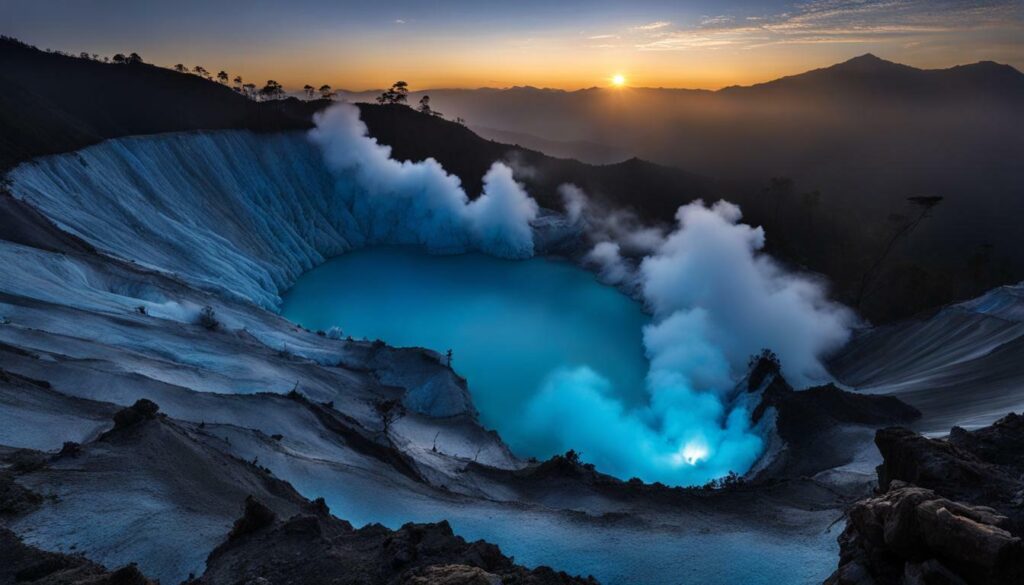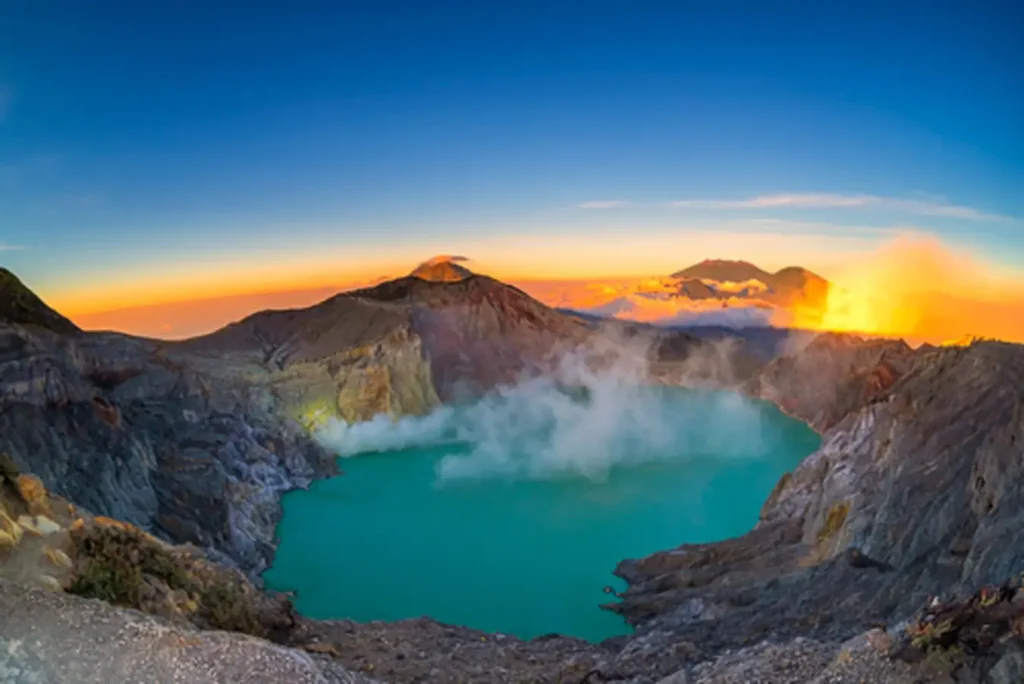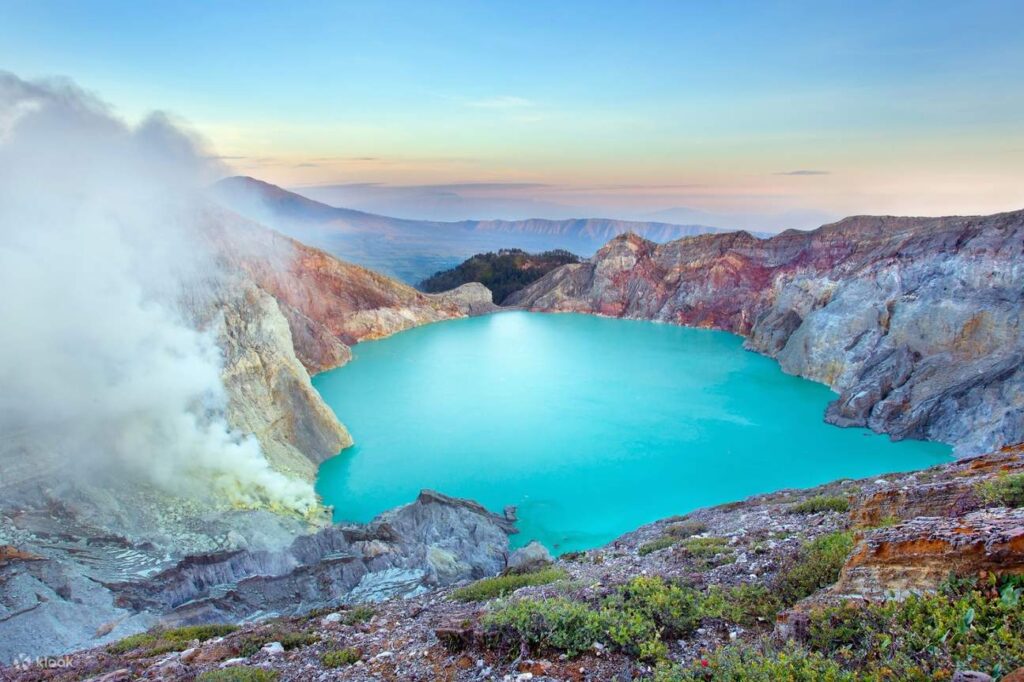One of the most captivating natural occurrences in the world is the Ijen Blue Fire, a mesmerizing display of blue flames that can only be witnessed at the Ijen Crater in East Java, Indonesia. The Ijen Blue Fire is a unique phenomenon that has fascinated visitors from all over the globe.
Located within the Ijen National Park, the Ijen Crater is a geological wonder that offers a stunning backdrop for the blue fire phenomenon. The turquoise acidic lake surrounding the crater and the rugged volcanic terrain create a lunar-like landscape that is simply breathtaking.
If you’re planning to witness the Ijen Blue Fire, it’s important to understand its unique characteristics and the science behind it. In this article, we will delve into the fascinating world of Ijen Blue Fire, exploring its geological formation, chemical reactions, and cultural significance.
Key Takeaways:
- The Ijen Blue Fire is a captivating phenomenon that can only be witnessed at the Ijen Crater in East Java, Indonesia.
- The Ijen Crater is a geological wonder that creates an otherworldly landscape.
- Understanding the science behind the blue fire phenomenon is crucial for a deeper appreciation of its beauty.
- Local legends and cultural beliefs surrounding the Ijen Blue Fire add to its significance.
- Proper safety precautions and considerations should be taken when planning a visit to the Ijen Crater.
The Ijen Crater – A Geological Wonder
The Ijen Crater, also known as Kawah Ijen, is a popular tourist destination located in East Java, Indonesia. It is a volcanic crater with a turquoise acidic lake at the center and is famous for its mesmerizing blue flame phenomenon, also known as the Ijen Blue Fire.
The Ijen Crater is situated at an elevation of 2,799 meters above sea level and is the largest acidic crater lake in the world. It was formed about 300,000 years ago and is part of the Ijen volcano complex, which includes the Gunung Merapi and Raung volcanoes.
What makes the Ijen Crater unique is its active sulfur mining operations, as well as the occurrence of the blue flame phenomenon. The blue flames are caused by the combustion of sulfuric gases that emerge from the cracks in the crater walls, particularly after dark.
The Ijen Blue Fire is one of the rarest natural occurrences in the world and can only be witnessed in a few places, including Iceland and Ethiopia. However, it is the Ijen Crater that is most famous for this phenomenon, attracting tourists from all over the world to witness its mesmerizing beauty.
Blue Fire Explained – The Science Behind the Spectacle
The Ijen Blue Fire is a result of natural occurrences that take place within the Ijen Crater. This phenomenon is created by the combustion of sulfuric gases that are emitted from the volcano’s vents and mix with oxygen-rich air under high temperatures.
The blue color of the flames is due to the combustion of sulfuric gases, which produce a blue glow that is visible at night. The high temperature of these flames is around 1,112°F (600°C), which is hot enough to melt the sulfur deposits and create liquid sulfur that flows down the sides of the vents.
The Ijen Volcano is one of the few places in the world to witness this rare natural occurrence. One of the reasons for this is the high concentration of sulfuric gases that are emitted from the vents. These gases react with oxygen in the air and ignite, creating the blue flames that can be seen at night.
The Chemistry Behind Ijen Blue Fire
The chemical reaction that creates the Ijen Blue Fire is a result of the high concentration of sulfuric gases in the Ijen Volcano. When these gases mix with oxygen-rich air, they ignite and produce two main chemical reactions:
- Sulfur dioxide (SO2) combines with oxygen (O2) to form sulfur trioxide (SO3).
- Sulfur trioxide (SO3) reacts with water (H2O) to form sulfuric acid (H2SO4).
The H2SO4 that is produced from the reaction is what creates the blue glow of the flames. This is because the H2SO4 molecules absorb energy from the flames and release the energy as blue light, giving the flames their unique blue color.
In conclusion, the Ijen Blue Fire is a rare and mesmerizing natural phenomenon that occurs due to a combination of chemical reactions and geological factors. Its unique blue flames are caused by the combustion of sulfuric gases that are emitted from the volcano’s vents and mix with oxygen-rich air under high temperatures. Understanding the chemistry behind this phenomenon helps to appreciate its rarity and beauty.
Witnessing the Phenomenon – Exploring Ijen Crater
Experiencing the Ijen Blue Fire phenomenon is a once-in-a-lifetime opportunity that should not be missed. To witness this mesmerizing sight, visitors must hike up to the Ijen Crater, located in East Java, Indonesia.
It is important to note that the Ijen Crater is an active volcano, and visitors should exercise caution and ensure they are physically prepared for the challenging hike. The best time to witness the blue flames is during the early hours of the morning, between 2:00 am and 4:00 am.
For those who prefer a guided tour, there are several options available. Local tour guides can be hired at the entrance to the Ijen National Park, and organized tours can be arranged through various travel agencies. It is recommended to book a tour in advance to secure a spot and ensure a hassle-free experience.
| Tour Type | Price Range (per person) | Inclusions |
|---|---|---|
| Ijen Crater Blue Fire Tour | $50-$100 | Transportation, local guide, entrance fee, gas masks |
| Ijen Crater Blue Flame Tour | $100-$150 | Transportation, local guide, entrance fee, gas masks, accommodation, breakfast |
It is highly recommended to wear appropriate clothing and gear, including sturdy hiking shoes, warm clothing, and a gas mask to protect against the sulphuric gas emissions. Visitors should also bring plenty of water and snacks for the hike.
The hike up to the Ijen Crater can take up to 2 hours and is considered strenuous. However, the breathtaking views of the crater and the turquoise acidic lake make the journey well worth the effort.
The Lunar-Like Landscape of Ijen Crater
Upon arriving at Ijen Crater, visitors are immediately struck by the otherworldly landscape that stretches before them. The rugged volcanic terrain, combined with its turquoise acidic lake, creates a scenery reminiscent of the moon’s surface.
The Ijen Crater is located at an altitude of 2,799 m above sea level, surrounded by a vast plateau that offers breathtaking panoramic views of the surrounding landscape. As visitors make their way towards the crater, they are met with a stunning landscape marked by lush tropical forests and cool mountain air.
As visitors journey closer to the crater’s edge, the smell of sulfur becomes more potent, a reminder of the geological activity that underlines the phenomenon. The blue flames can be viewed from a safe distance on the crater’s edge, allowing visitors to observe the phenomenon without endangering themselves.
Exploring the Ijen Crater is a unique experience, offering visitors a glimpse into the awe-inspiring power of nature.
Safety Precautions and Considerations
When planning a visit to witness the Ijen Blue Fire, safety should always be a primary concern. The trek up to the crater can be challenging, and the presence of toxic gases in the area can pose a serious threat to your health.
If you decide to go on your own, ensure that you are physically fit and properly equipped. A gas mask or respirator is essential to protect yourself from the harmful gases that are released from the crater. Additionally, wear sturdy boots or shoes with good grip, and carry a flashlight or headlamp to navigate the dark path.
Alternatively, you can opt for a guided tour for a more organized and safer experience. Many local tour operators offer reasonable packages that include transportation, a knowledgeable guide, and the necessary safety equipment. These tours are highly recommended for first-time visitors.
It is also important to respect the rules and regulations set by the park authorities. Do not wander off the designated paths or approach the crater too closely. Smoking is strictly prohibited in the area, as it can trigger fires and contribute to the release of toxins.
By taking the necessary precautions and following the guidelines, you can ensure a safe and enjoyable experience at the Ijen Crater.
Local Legends and Cultural Significance
The Ijen Blue Fire holds great cultural significance for the local communities surrounding the volcano. According to local beliefs, the blue flames are the result of a battle between the spirits of the volcano and the gods of the earth. The story goes that the blue flame is the manifestation of the spirits’ anger towards those who do not respect the natural world.
For the people of East Java, Ijen Crater represents a portal between the physical and spiritual worlds. The volcano and its mythical blue flames feature prominently in the region’s spiritual practices and ceremonies, including weddings and child blessings.
Visitors to Ijen are often struck by the deep reverence with which the locals regard the volcano. While the blue fire phenomenon may be a marvel of science, it is also a reminder of the sacred power and beauty of nature.
Photography Tips for Capturing the Ijen Blue Fire
For photography enthusiasts, witnessing the Ijen Blue Fire can be an awe-inspiring experience that begs to be captured on camera. Here are some essential tips for capturing the perfect shot:
Choose the Right Camera
It is recommended to use a DSLR or mirrorless camera that allows you to adjust the exposure settings manually. A high-quality lens with a wide aperture will help to capture more light and produce sharper images.
Adjust Camera Settings
Manual mode is essential to control the exposure settings for night photography. Adjust the shutter speed to 30 seconds or more, the aperture to f/2.8 or wider, and the ISO to the highest possible without introducing too much noise.
Use a Tripod
A sturdy tripod is essential for night photography to keep the camera steady during long exposures. Use a remote trigger or self-timer to avoid camera shake when pressing the shutter button.
Experiment with Composition
The stunning blue flames make for an incredible subject, but don’t forget to experiment with composition. Including other elements of the landscape, like the stars or the volcanoes’ silhouette, can add a unique perspective to your shots.
Beware of the Toxic Fumes
Safety should always come first when photographing the Ijen Blue Fire. Avoid getting too close to the flames and wear protective gear, especially when dealing with toxic fumes from the volcano’s sulfuric acid gas.
Best Time to Visit Ijen Crater
If you’re planning on witnessing the mesmerizing Ijen Blue Fire, timing is everything. The optimal time to visit Ijen Crater for viewing the blue flames is during the dry season, which runs from April to October. This is when the skies are clearer, and there is less risk of rain or fog obstructing the view.
It’s important to note that the blue flames are only visible at night. The best time to start the trek up to the crater is in the early hours of the morning, around 1:00 am to 2:00 am. This will allow enough time to reach the summit and witness the blue flames at their brightest, usually around 4:00 am to 5:00 am.
It’s worth keeping in mind that visibility is highly dependent on weather conditions. Even during the dry season, there may be occasional rain or fog that could obstruct the view. It’s recommended to check the weather forecast before planning a visit.
Another factor to consider is the moon phase. A full moon can make it challenging to see the blue flames clearly, so it’s ideal to plan your visit during a new moon phase.
Overall, the best time to visit Ijen Crater for the blue flames is during the dry season, in the early hours of the morning, and during a new moon phase to increase the likelihood of a clear view of this incredible natural wonder.
Alternative Attractions in the Ijen National Park
While the Ijen Blue Fire is undoubtedly the main highlight of a visit to Ijen National Park, there are other attractions worth exploring in the area. Here are some alternative options for those seeking a well-rounded adventure:
- Explore the Waterfalls: There are several stunning waterfalls located within the Ijen National Park, including Blawan Waterfall and Jagir Waterfall. Take a refreshing dip in the cool waters and take in the natural beauty of the surrounding area.
- Hike to the Top of Mount Merapi: For the more adventurous visitors, hiking to the summit of Mount Merapi provides a challenging and rewarding experience. The hike takes around 4-5 hours, and the panoramic views from the top are worth the effort.
- Visit the Sulfur Mines: The sulfur mines surrounding the Ijen Crater provide a unique insight into the daily lives of the local miners. Take a tour and witness the backbreaking work involved in extracting sulfur from the depths of the crater.
- Experience the Local Culture: Take time to visit nearby villages and immerse yourself in the local culture. From traditional dance performances to sampling local delicacies, there are plenty of opportunities to learn about the rich cultural heritage of the area.
- Book a Guided Tour: For those short on time or looking for a convenient way to explore the area, guided tours are available. Choose from a range of options, including Ijen Crater Blue Fire tours and Ijen Crater Blue Flame tours.
Planning Your Visit
When planning a visit to Ijen National Park, be sure to allocate enough time to fully explore the area. Depending on your interests, a stay of 2-3 days is recommended.
It’s also important to note that some of the activities, such as hiking to the summit of Mount Merapi or visiting the sulfur mines, require a certain level of physical fitness. Make sure to assess your abilities and choose activities that are suitable for you.
Lastly, be sure to book any tours or accommodation in advance, particularly during peak season. This will ensure a smoother and more enjoyable experience during your visit to Ijen National Park.
Unraveling the Enigma of Ijen Blue Fire
The Ijen Blue Fire phenomenon is a natural occurrence that continues to captivate and mystify travelers from all over the world. Its mesmerizing blue flames, which can reach up to five meters high, create a breathtaking scene that is truly one-of-a-kind.
Despite its awe-inspiring beauty, the origins of the Ijen Blue Fire remain somewhat mysterious. The scientific explanation lies in the presence of sulfuric gases that ignite upon contact with the air, resulting in the blue flames. However, the appearance of these flames only at one specific location on Earth – Ijen Crater – continues to intrigue scientists and visitors alike.
The Significance of Ijen Blue Fire
Ijen Blue Fire holds great cultural significance for the local communities surrounding the volcano. It is believed to be the manifestation of a powerful spirit residing in the volcano, and the blue flames are often associated with prosperity and good fortune. Many locals undertake ritualistic offerings to the volcano as a way of giving thanks and praying for continued blessings.
Moreover, the Ijen Blue Fire phenomenon helps to support the local economy through tourism. Visitors from around the world flock to Ijen Crater to witness this natural wonder, contributing to the growth of local businesses and job opportunities.
Experiencing the Ijen Blue Fire
There’s no denying the enchantment of the Ijen Blue Fire, and witnessing it firsthand is an experience that should not be missed. However, it’s important to take precautions and plan accordingly to ensure a safe and enjoyable visit.
Visitors are advised to join guided tours to Ijen Crater, as the journey can be challenging and requires proper equipment such as gas masks and sturdy footwear. Additionally, it’s crucial to respect the local regulations and avoid venturing off designated paths.
In Conclusion
The Ijen Blue Fire continues to captivate and enthrall visitors with its enigmatic beauty. As a natural wonder, it serves as a reminder of the immense power of the planet and the majesty of nature. Witnessing the Ijen Blue Fire is a rare and unforgettable experience that will leave a lasting impression on anyone fortunate enough to see it.
FAQ
What is the Ijen Blue Fire phenomenon?
The Ijen Blue Fire phenomenon refers to the mesmerizing blue flames that can be seen at the Ijen Crater in East Java, Indonesia. It is a unique natural occurrence that attracts tourists from around the world.
How is the blue fire formed at the Ijen Crater?
The blue fire at the Ijen Crater is formed due to the combustion of sulfuric gases emitted by the volcano. The high temperature of the gases, combined with the presence of sulfuric compounds, creates the stunning blue flames that appear in the dark.
Can anyone visit the Ijen Crater to witness the blue fire?
Yes, anyone can visit the Ijen Crater to witness the blue fire phenomenon. However, it is advisable to join a guided tour for safety purposes and to ensure a smooth experience. The crater is accessible to both amateur and professional explorers.
Is it safe to visit the Ijen Crater?
Safety should always be a top priority when visiting the Ijen Crater. It is essential to follow the instructions and guidelines provided by the local authorities and tour guides. Proper safety equipment, such as masks and flashlights, should be used to protect against harmful gases and to navigate the dark terrain.
What is the best time to visit the Ijen Crater for witnessing the blue fire?
The blue fire at the Ijen Crater is most visible during the darkest hours of the night. It is recommended to visit between 1 am to 4 am when the flames are at their brightest. However, it is important to check with local tour operators for the current viewing conditions and timings.
Are there any alternative attractions in the Ijen National Park?
Yes, apart from the incredible blue fire phenomenon, the Ijen National Park offers other attractions worth exploring. Visitors can enjoy hiking trails that lead to breathtaking viewpoints, stunning waterfalls, and immerse themselves in the local cultural experiences.
Can I capture photographs of the blue fire?
Yes, it is possible to capture photographs of the enchanting blue fire phenomenon. However, due to the low light conditions, it requires proper camera settings and techniques. It is recommended to use a tripod, adjust the ISO settings, and experiment with long exposure to capture the vibrant blue flames.
What are the local legends and cultural significance associated with the Ijen Blue Fire?
The Ijen Blue Fire holds great cultural significance for the local communities surrounding the volcano. There are various legends and myths associated with the phenomenon, which are deeply ingrained in the cultural beliefs and traditions of the people living in the area.
Are there any safety precautions I should take before visiting the Ijen Crater?
Before visiting the Ijen Crater, it is important to take certain safety precautions. This includes being physically prepared for the hike, wearing appropriate clothing and footwear, carrying essential safety equipment, following the instructions of the local guides, and being aware of the local regulations and guidelines.
What makes the Ijen Blue Fire phenomenon unique?
The Ijen Blue Fire phenomenon is unique due to its rarity. It is one of the few places on Earth where blue fire can be witnessed. The combination of the volcanic activity, sulfuric gases, and the dark surroundings create a breathtaking and mystical experience that captivates visitors.





